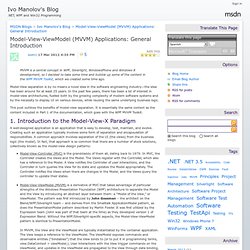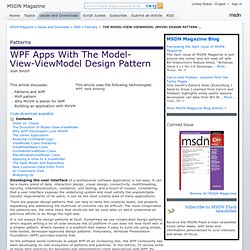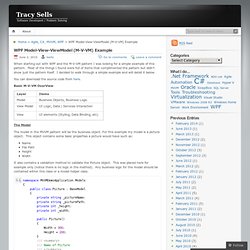

Model-View-ViewModel (MVVM) Applications: General Introduction - Ivo Manolov's Blog. MVVM is a central concept in WPF, Silverlight, WindowsPhone and Windows 8 development, so I decided to take some time and bubble up some of the content in the WPF MVVM Toolkit, which we created some time ago.

Model-View separation is by no means a novel idea in the software engineering industry—the idea has been around for at least 25 years. In the past few years, there has been a lot of interest in model-view architectures, fuelled both by the growing complexity of modern software systems and by the necessity to display UI on various devices, while reusing the same underlying business logic. .NET Design Patterns in C# and VB.NET - Gang of Four (GOF) - DoFactory.
Design patterns are solutions to software design problems you find again and again in real-world application development.

Patterns are about reusable designs and interactions of objects. The 23 Gang of Four (GoF) patterns are generally considered the foundation for all other patterns. They are categorized in three groups: Creational, Structural, and Behavioral (for a complete list see below). To give you a head start, the C# source code for each pattern is provided in 2 forms: structural and real-world. Structural code uses type names as defined in the pattern definition and UML diagrams. A third form, .NET optimized, demonstrates design patterns that fully exploit built-in .NET 4.5 features, such as, generics, attributes, delegates, reflection, and more. Command Design Pattern in C# and VB.NET. Painless Functional Specifications - Part 1: Why Bother? By Joel Spolsky Monday, October 02, 2000 When The Joel Test first appeared, one of the biggest sore points readers reported had to do with writing specs.

It seems that specs are like flossing: everybody knows they should be writing them, but nobody does. Why won't people write specs? People claim that it's because they're saving time by skipping the spec-writing phase. I believe that on any non-trivial project (more than about 1 week of coding or more than 1 programmer), if you don't have a spec, you will always spend more time and create lower quality code. The most important function of a spec is to design the program. Let's visit two imaginary programmers at two companies.
Speedy and Mr. Speedy decides that the best way to provide backwards compatibility is to write a converter which simply converts 1.0 version files into 2.0 version files. Now, Mr. When opening a file created with an older version of the product, the file is converted to the new format. Another 20 minutes have elapsed. TechDays 2010: Understanding the Model-View-ViewModel pattern. Deep Dive MVVM. THE MODEL-VIEW-VIEWMODEL (MVVM) DESIGN PATTERN FOR WPF. Patterns WPF Apps With The Model-View-ViewModel Design Pattern Josh Smith Developing the user interface of a professional software application is not easy.

It can be a murky blend of data, interaction design, visual design, connectivity, multithreading, security, internationalization, validation, unit testing, and a touch of voodoo. Considering that a user interface exposes the underlying system and must satisfy the unpredictable stylistic requirements of its users, it can be the most volatile area of many applications. There are popular design patterns that can help to tame this unwieldy beast, but properly separating and addressing the multitude of concerns can be difficult. It is not always the design patterns at fault. As the software world continues to adopt WPF at an increasing rate, the WPF community has been developing its own ecosystem of patterns and practices. Order vs. It is unnecessary and counterproductive to use design patterns in a simple "Hello, World!
" Figure 1 Workspaces. WPF Model-View-ViewModel (M-V-VM) Example Tracy Sells. When starting out with WPF and the M-V-VM pattern I was looking for a simple example of this pattern.

Most of the things I found were full of items that complimented the pattern but didn’t show just the pattern itself. I decided to walk through a simple example and will detail it below. You can download the source code from here. Basic M-V-VM OverView The Model The model in the MVVM pattern will be the business object. NameFile PathHeightWidth It also contains a validation method to validate the Picture object. Base Model Class This class is used to provide functionality to each model class without the need to replicate code.